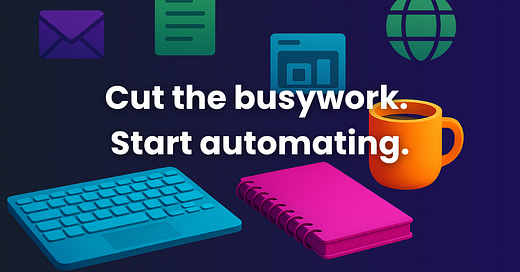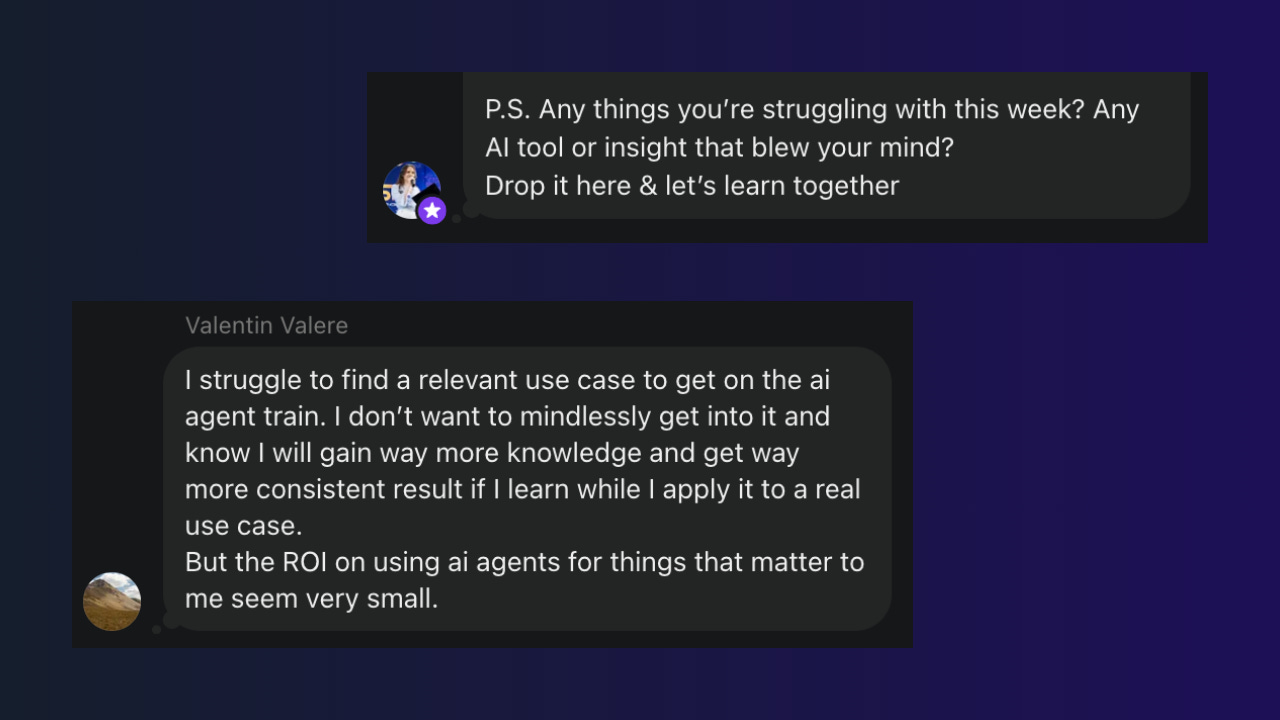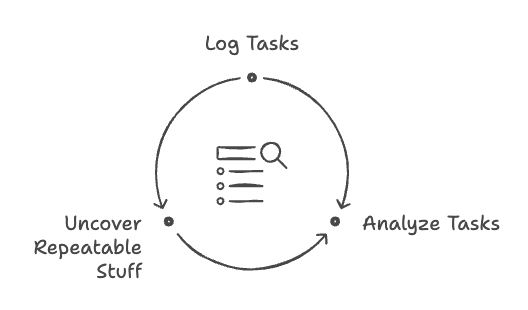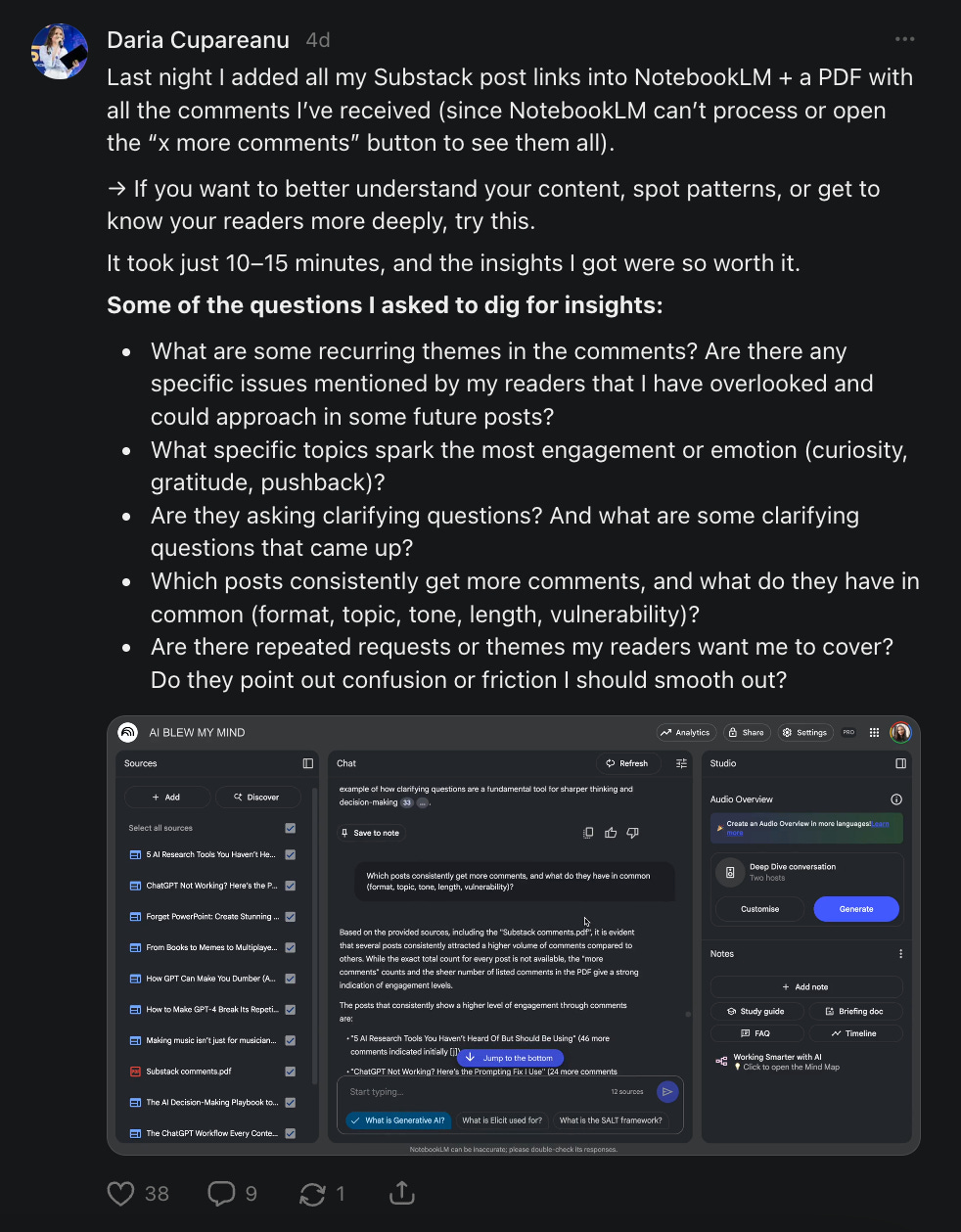The 4-Part System to Find Your Biggest Time-Wasters, Automate Them, and Win Back 10+ Hours Every Week
A practical system for busy entrepreneurs, creators, and professionals who want to free up hours, cut the busywork, and make space for what actually moves them forward.
A few days ago, I was on the phone with my mom.
She’s spent her entire career in finance, years of navigating numbers, regulations, reports. She’s sharp, experienced, and deeply familiar with her workflows.
Since I spend so much time experimenting with AI and exploring small daily automations, I casually asked her:
“Is there anything manual or repetitive in your workflow?”
She paused for a moment, thinking.
Nothing immediately came to mind, so I offered some suggestions:
“What about checking fiscal updates? Manually entering data? Preparing reports?”
Eventually, we uncovered a few things.
But what surprised me wasn’t the tasks we found, it was how hard they were to surface.
And it became clear to me. We all deal with this.
Just last night, one of my readers,
, confirmed it unprompted when I asked a question in my subscriber group chat.Valentin put it plainly. He doesn’t want to waste time learning AI agents just for the sake of it. He wants them to solve a real problem so he can actually benefit.
And I’m sure you want the same.
That’s why this post kicks off a series. I’ll share practical automations shaped by what you tell me you need.
After you apply the system I’m about to walk you through, come back and tell me what you find. Where are you stuck? Where are you wasting time? Where do you wonder: “isn’t there an easier way?”
Why we’re blind to the time-sucking tasks we could actually get rid of
It’s not that we don’t have repetitive tasks in our day. It’s that they become so familiar, we stop noticing them. They fade into the background, just part of “how things are done”.
Even though I’m much closer to this AI space, I’m no exception. I still miss repetitive work hiding right under my nose because it’s blended into habit, and I haven’t stopped to rethink it.
Our brains simply aren’t wired to constantly question familiar patterns.
We’re creatures of habit. We get used to doing things a certain way, and over time, we stop noticing that those things might be slowing us down.
I remember some years ago when I was learning advanced Excel. The deeper I went, the more I realized:
Whenever something feels painfully manual or overly repetitive, there’s almost always another way to handle it.
Back then, it was about Excel formulas. Today, with the explosion of low-code tools, AI helpers, and automation platforms, that’s even more true. You don’t need to know how to code. You don’t need to be a technical wizard. But you need to know how to spot the right opportunities and apply the right shortcuts.
Just like in psychology, if you want to change a behavior, the first step isn’t action. It’s observation. You need to become aware of what you’re doing, when you’re doing it, and how often it’s showing up. Only then can you start to redesign it.
And if you don’t train yourself to spot the inefficiencies around you, they’ll keep slipping by, no matter how many tools you have at your fingertips.
A simple system to spot (and stop) the tasks wasting your time
That’s why I’m sharing a simple system you can start using today to uncover the hidden, repetitive tasks draining your time and energy.
All it takes is five days of watching how you work, and maybe one more hour to look back and spot the patterns.
So let’s get into it.
Step 1. Track your tasks: what you did and how you did it
You can’t improve what you don’t measure, so your first move is to build awareness.
For one full week, track your daily tasks.
Don’t just write what you did, write how you did it, and how long it took.
Ask yourself:
What triggered this task?
How did I approach it?
What steps did I follow?
What was the final result or output?
Use whatever system works for you to write down your activities and tasks (Google Calendar, a notebook, your notes app, a doc, or a spreadsheet).
For example, don’t just write “sent client report”. Be as detailed and specific as possible. Here’s a few examples:
“Gathered data from system A, pasted it into Excel, cleaned columns, saved as PDF, emailed to client.”
“Created social media posts using ChatGPT, manually saved them in a Word document, organized them by days, then posted one per day.”
“Reviewed new leads in the CRM, manually checked LinkedIn profiles, sent connection requests, followed up with personalized messages.”
At the end of the week, this exercise will give you a clear record of not just what you did but how you did it. That’s where you’ll start seeing the first clues for what you can automate.
And yes, I know this takes time. It’s uncomfortable and annoying. It’ll cost you maybe one or two minutes after each task. But it’s worth it. You’re trading some time now to buy back 2, 10, maybe even 30 hours every week going forward.
That’s a deal worth making.
Step 2: Spot the patterns and find the repeatable, manual stuff
This step is essential. Repetition and manual work equals automation opportunity. If you’re doing the same thing over and over, there’s probably a tool or system that can take it off your hands.
There’s no sense to make an automation for everything. But once you have some activities that are highly repetitive and manual, it’s definitely worth it to get your hands off that so you can focus on other more important things.
So now that you’ve got a detailed log, it’s time to pull it apart and look for patterns.
Go back through your task list and mark anything that stands out, starting with tasks you did three or more times and anything that felt manual and repetitive.
Some things to watch for:
Moments where you copied, pasted, or moved info between tools.
Repetitive cleanup work, like renaming files, editing layouts, or cleaning data.
Repeated follow-up emails or messages that follow the same structure.
Regular updates to dashboards, spreadsheets, or status trackers.
Rebuilding the same types of documents or slides over and over with only small changes.
You can do this manually, or…
You can prompt any LLM (ChatGPT, Claude, Gemini) to help you extract these insights.
Here’s a prompt you can use:
Help me analyze my weekly tasks to spot patterns and identify inefficiencies in my workflow.
Your job is to thoroughly review the provided task log, identify patterns, and suggest opportunities for automation, batching, or tool integration.
CONTEXT
You will receive a detailed log of tasks from the past week, including the time I spent on each task, what each task consisted of, the steps I followed to complete it, and the output it produced.
Follow these exact steps in order:
1. Ask me clarifying questions first.
- Wherever the notes are unclear or missing detail, ask follow-up questions before jumping to conclusions.
- If a task description is vague, ask me for the specific steps involved.
- If you’re unsure why a task took as long as it did, ask if there were delays or blockers.
- If multiple tools are mentioned but the connection is unclear, ask how I transfer information between them.
- If you notice similar tasks but aren’t sure if they’re related, ask for clarification.
Do this:
- Ask one question at a time, until you have all the information you need to start analyzing my task log. Only move to the next step after you have everything clear.
Do not:
- Never make assumptions, ask for clarification where needed.
2. Once you've gathered everything you need, review the tasks and break them into categories.
3. Highlight which tasks were repeated at least three times.
4. Identify where manual information transfer occurred between tools.
5. Point out steps that look unnecessarily manual, repetitive, or time-consuming.
6. Suggest tasks or patterns that could be good candidates for automation, batching, or tool integration.
OUTPUT FORMAT
Start with a clear, high-level summary (3–5 sentences) of the most important patterns, inefficiencies, and opportunities you discovered. Highlight anything that stands out, surprises, or seems especially ripe for optimization.
Then, present a table that maps out all of my tasks, organized into categories. The table should include columns like: task name, category, % of total time (per task and summed per category), how often the task showed up, total time spent (per task), manual information you identified, repetitive tasks, automation or optimization opportunity.
After the table, provide an extensive narrative analysis. Look for hidden time sinks and highlight which categories or specific tasks eat up disproportionate time or attention. Point out where patterns suggest poor tool integration or workflow friction and identify the areas that offer the biggest potential payoff if improved. Consider both the quick wins that can deliver immediate value and the deeper, more strategic shifts that could transform the overall workflow over time.
Your goal is to help me see not just what I did, but where the leverage points are, where small changes could unlock major improvements.
Below is my detailed task log from the past week.
[PASTE TASK LOG HERE]
You can feed your last week’s tasks to NotebookLM and let it do the processing for you.
Drop in your calendar, copy-paste what each task involved, and then chat with it using questions like:
What tasks did I repeat most often?
Where was I doing manual data transfer or copy-paste work?
Which steps took longer than expected?
Where did I switch between tools frequently?
What types of tasks could be grouped or batched together?
Which parts of my workflow look like good candidates for automation?
NotebookLM is an amazing tool for spotting patterns.
And if you tracked your time by hand in a notebook, no worries. Just snap a few photos of your notes, feed them into GPT, and it’ll transcribe them for you so you can analyze everything digitally.
Here’s another use case I ran through NotebookLM to give you an idea of how it works.
Step 3: Find the friction and bottlenecks
Next, look for slowdowns.
These are the moments where you pause, get stuck, or feel a bit annoyed. I’m sure you’ve felt it, that moment of, “Why is this so messy?” or “Why does this take so long?”
So ask yourself:
Where did I lose time or momentum?
Which steps felt clunky or unnecessarily complicated?
Did I ever think “there has to be an easier way”?
These little friction points are gold.
They show you exactly where AI or automation can help, by connecting tools, moving data for you, or cutting down boring manual work.
And it’s not just about the tasks you do all the time. Maybe once in a while you do big research, like checking 10 news sites. Even if it’s not a weekly thing, you could still build an automation that pulls the data from the websites you trust and drops it into Notion or a spreadsheet, or even sends you a weekly email summary.
Or maybe you have a bunch of random notes on your phone, ideas you keep writing down but never look at again. You could set up a little agent or mini-app that grabs those notes, runs them through GPT to summarize, and organizes them neatly in Notion as action points.
It’s not just about saving time, it’s about making space for the work that really matters to you.
Step 4: Test and learn
Finally, pick one task to experiment with.
Don’t try to automate your entire workflow all at once, that’s a fast track to burnout and messy, half-working systems. Instead, start with one small, repetitive task you uncovered. Prioritize the ones you most want to automate, then just pick one to test first.
To help you get started, here’s a prompt you can drop into GPT that will guide you on how to automate the task you chose:
Help me think step by step about how I could automate this task: [DESCRIBE YOUR TASK].
Walk me through the possible tools, steps, and options, and help me choose the best starting point.If the first task feels too complex, no worries. Feed GPT a few more of your tasks and pick the one automation that seems most doable right now.
Let AI guide you to set up the automation, whether it’s using Zapier, Make, n8n, an action GPT, or another tool, and see what happens.
If it works, great. You can stack it with other tools, expand the flow, or even teach it to your team. If it doesn’t work the first time, that’s fine too. Tweak, learn, and try again. This is all about iteration, not perfection.
Ready to clear the clutter and focus on what moves you forward?
What I absolutely hate is when a day slips by and I realize I didn’t do anything that actually moved me closer to my goals.
Output isn’t measured by how much you did, how many boxes you ticked, or how busy you felt, it’s measured by how much of it actually moved you closer to where you want to go.
Too often, we let manual, repetitive tasks eat up our time without even noticing. So let me help you change that.
If you try this exercise, even just Step 1 for a few days, drop a comment and tell me: What repetitive or clunky task did you uncover that you’d like help with? I’ll pick a few and include them in the next part(s) of this series, where I’ll come up with solutions for you.
Let’s stop missing the automations hiding right under our noses. Let’s make the invisible, visible.









Nice practical breakdown of how to spot the inefficiencies! It's a good reminder to slow down and be intentional about how we're working and wether it's still serving us and our goals.
Something I've been doing lately is dumping my tracked activities from Rize (an automatic time tracker) into gpt and asking it how I can improve the way I work. Usually it'll tell me I'm task switching too much (which is spot on). It told me I should batch my content and dedicate times during the day to engage to avoid context switching and burning energy.
Feel like I can resonate with almost every sentence in this article!
The way it captures how people get trapped in routine, and the psychology behind lost productivity, is spot on.
Even when we’re trying to stay intentional, things still manage to slip through the cracks.
I really needed these strategies. Now I’ve got a whole list of areas to optimize!